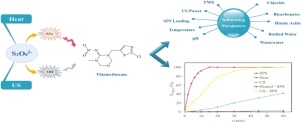当前位置:
X-MOL 学术
›
Process Saf. Environ. Prot.
›
论文详情
Our official English website, www.x-mol.net, welcomes your
feedback! (Note: you will need to create a separate account there.)
Degradation of pesticide thiamethoxam by heat – activated and ultrasound – activated persulfate: Effect of key operating parameters and the water matrix
Process Safety and Environmental Protection ( IF 6.9 ) Pub Date : 2020-02-01 , DOI: 10.1016/j.psep.2019.11.041 Hafida Lebik-Elhadi , Zacharias Frontistis , Hamid Ait-Amar , Farid Madjene , Dionissios Mantzavinos
Process Safety and Environmental Protection ( IF 6.9 ) Pub Date : 2020-02-01 , DOI: 10.1016/j.psep.2019.11.041 Hafida Lebik-Elhadi , Zacharias Frontistis , Hamid Ait-Amar , Farid Madjene , Dionissios Mantzavinos

|
Abstract This work studied the degradation of pesticide thiamethoxam (TMX) by heat-activated and ultrasound-activated persulfate systems. The effect of different parameters on degradation in ultrapure water, such as initial pH (3–10), sodium persulfate (SPS) concentration (50−1000 mg/L), TMX concentration (1−10 mg/L), temperature (20−70 °C) and ultrasound power density (20−42 W/L) were examined. For the heat-activated system, TMX degradation increased with increasing temperature and SPS concentration and was favored at pH 6; the activation energy was computed at 108.7 kJ/mol based on the Arrhenius law. Ultrasound alone was capable of partially degrading TMX, but the process was favored in the presence of SPS. For the ultrasound-activated system, degradation increased with increasing SPS concentration and power density at pH 6. The effect of temperature was controversial since the beneficial effect of high temperatures on SPS activation is offset by the reduced sonochemical activity due to the “cushioning” effect. Regardless of the activation system, the presence of chloride, bicarbonate and humic acid impeded TMX removal. Besides, TMX degradation was reduced in actual matrices, i.e. wastewater and bottled water, showing the competition between TMX and other matrix constituents for free radicals. For either system, mineralization was slower than TMX degradation, implying the formation of persistent by-products.
中文翻译:

通过热活化和超声波活化过硫酸盐降解农药噻虫嗪:关键操作参数和水基质的影响
摘要 本工作研究了热活化和超声活化过硫酸盐系统对农药噻虫嗪 (TMX) 的降解。不同参数对超纯水降解的影响,如初始 pH (3-10)、过硫酸钠 (SPS) 浓度 (50-1000 mg/L)、TMX 浓度 (1-10 mg/L)、温度 (20 -70 °C) 和超声功率密度 (20-42 W/L)。对于热活化系统,TMX 降解随着温度和 SPS 浓度的增加而增加,并且在 pH 6 时有利于;根据阿伦尼乌斯定律,活化能计算为 108.7 kJ/mol。单独的超声能够部分降解 TMX,但该过程在 SPS 存在下更受青睐。对于超声激活系统,在 pH 6 时,降解随着 SPS 浓度和功率密度的增加而增加。温度的影响是有争议的,因为高温对 SPS 激活的有益影响被“缓冲”效应导致的声化学活性降低所抵消。无论活化系统如何,氯化物、碳酸氢盐和腐殖酸的存在都会阻碍 TMX 的去除。此外,TMX 在实际基质中的降解减少,即废水和瓶装水,表明 TMX 和其他基质成分之间存在自由基竞争。对于任一系统,矿化都比 TMX 降解慢,这意味着持久性副产品的形成。碳酸氢盐和腐殖酸阻碍了 TMX 的去除。此外,TMX 在实际基质中的降解减少,即废水和瓶装水,表明 TMX 和其他基质成分之间存在自由基竞争。对于任一系统,矿化都比 TMX 降解慢,这意味着持久性副产品的形成。碳酸氢盐和腐殖酸阻碍了 TMX 的去除。此外,TMX 在实际基质中的降解减少,即废水和瓶装水,表明 TMX 和其他基质成分之间存在自由基竞争。对于任一系统,矿化都比 TMX 降解慢,这意味着持久性副产品的形成。
更新日期:2020-02-01
中文翻译:

通过热活化和超声波活化过硫酸盐降解农药噻虫嗪:关键操作参数和水基质的影响
摘要 本工作研究了热活化和超声活化过硫酸盐系统对农药噻虫嗪 (TMX) 的降解。不同参数对超纯水降解的影响,如初始 pH (3-10)、过硫酸钠 (SPS) 浓度 (50-1000 mg/L)、TMX 浓度 (1-10 mg/L)、温度 (20 -70 °C) 和超声功率密度 (20-42 W/L)。对于热活化系统,TMX 降解随着温度和 SPS 浓度的增加而增加,并且在 pH 6 时有利于;根据阿伦尼乌斯定律,活化能计算为 108.7 kJ/mol。单独的超声能够部分降解 TMX,但该过程在 SPS 存在下更受青睐。对于超声激活系统,在 pH 6 时,降解随着 SPS 浓度和功率密度的增加而增加。温度的影响是有争议的,因为高温对 SPS 激活的有益影响被“缓冲”效应导致的声化学活性降低所抵消。无论活化系统如何,氯化物、碳酸氢盐和腐殖酸的存在都会阻碍 TMX 的去除。此外,TMX 在实际基质中的降解减少,即废水和瓶装水,表明 TMX 和其他基质成分之间存在自由基竞争。对于任一系统,矿化都比 TMX 降解慢,这意味着持久性副产品的形成。碳酸氢盐和腐殖酸阻碍了 TMX 的去除。此外,TMX 在实际基质中的降解减少,即废水和瓶装水,表明 TMX 和其他基质成分之间存在自由基竞争。对于任一系统,矿化都比 TMX 降解慢,这意味着持久性副产品的形成。碳酸氢盐和腐殖酸阻碍了 TMX 的去除。此外,TMX 在实际基质中的降解减少,即废水和瓶装水,表明 TMX 和其他基质成分之间存在自由基竞争。对于任一系统,矿化都比 TMX 降解慢,这意味着持久性副产品的形成。











































 京公网安备 11010802027423号
京公网安备 11010802027423号